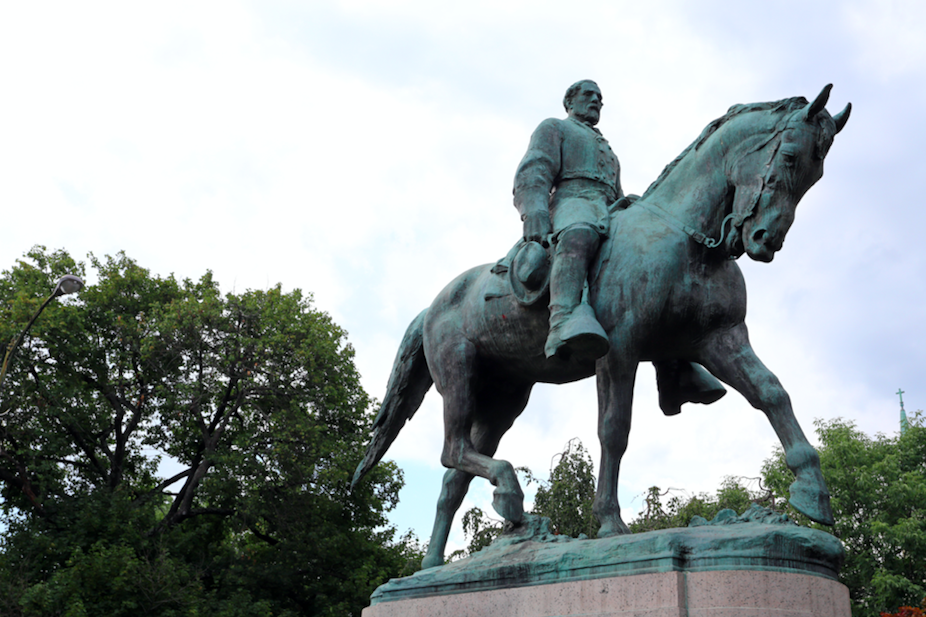The violent scenes in Charlottesville, Virginia, that led to the death of one woman and left many more injured began as a dispute over a statue of General Robert E. Lee, which sits in a local public park. However, the controversy feeds into a much wider debate that is as old as the United States itself. So who was Lee and why does a memorial to him trouble so many people?
The meeting of white supremacists in Charlottesville was originally held under the pretext of demonstrating against plans to remove the statue. The Charlottesville city council voted in February for it to be removed from the recently renamed Emancipation Park (formerly Lee Park). The decision came as part of a movement to challenge the ubiquity of Confederate symbols in the South.
These statues, for their opponents, signify the oppression of African Americans under slavery and the Jim Crow segregation laws. They serve as daily reminders of the vulnerability of black people. The message of such monuments is the same to many of their defenders, even if their interpretation is different. To the white supremacists who gathered on the streets of Charlottesville, the statue of Lee represents white military and political power.
In the decades after the Civil War, memorials celebrating the south’s valiant effort and glorious defeat appeared all over the region. They embodied the myth of the “lost cause” – the idea that the war had been fought to defend states’ rights, rather than slavery. In this interpretation, the south only lost because of the industrial might of the northern “aggressor”.
This doctrine came to prominence during the Jim Crow era when whites implemented racial segregation through violent, extra-legal and then legal means. The lost cause memory was used to justify and enforce white supremacy.
For many, the Confederate memorials continue to represent this repression. They are a celebration of southern identity as white. Since the rise of the Black Lives Matter movement, the slogan “BLM”, as well as the names of victims of police shootings have appeared on memorials around the country. “Black Lives Matter” was sprayed on Charlottesville’s Lee statue in the days following the Charleston church shootings in 2015. Along with calls for the removal of Confederate flags from civic buildings there have been increasingly vocal, and successful, demands to reconsider the place of monuments in public spaces.
Who was Robert E. Lee?
The statue in Charlottesville is of Lee atop his horse, Traveller. The Confederate general and native of Virginia holds a hat in one hand and his horse’s reins in the other, his sword ready at his side.
It was unveiled by Lee’s great-granddaughter at a ceremony in May 1924. As was the custom on these occasions it was accompanied by a parade and speeches. In the dedication address, Lee was celebrated as a hero, who embodied “the moral greatness of the Old South”, and as a proponent of reconciliation between the two sections. The war itself was remembered as a conflict between “interpretations of our Constitution” and between “ideals of democracy.”
Here was the states’ rights argument. The south fought a noble war over its right to self-determination, rather than an effort to keep millions enslaved. Lee, claimed one of the speakers, “abhorred slavery”. In his position as commander of the Confederate Army of North Virginia, Lee represented military endeavour rather than a political struggle to uphold human bondage.
This has made Lee a powerful symbol of the Confederacy. He allowed white southerners to ignore the central role of slavery in the war. They could forget that the southern states seceded in order to uphold slavery and that their defeat meant freedom to millions of enslaved people. There was no space for black memories of emancipation in the south’s public spaces. Confederates were white and their monuments were celebrations of whiteness.
Lee is one of the most frequent figures to be memorialised in statues, aside from the common soldier. In 2016, the Southern Poverty Law Center catalogued all publicly supported spaces dedicated to the Confederacy, finding 203 examples named for Robert E. Lee. Streets, highways, counties, cities, parks, monuments and 52 public schools are named for the Confederate general. Up until 2015, Lee’s birthday was officially marked in five states.
The same year as Lee’s statue appeared in Charlottesville, Virginia passed laws which strengthened definitions of who was “colored” and who was “white”, and which reinforced the law prohibiting interracial marriage. Then, two years later, the state passed a law to enforce racial segregation in places of public entertainment.
The monument to Lee served the same purpose as the legislation – to remind African Americans of their perceived place and inferiority. White nationalists gathered to protect the statue in 2017 because they wanted to celebrate its message. Like the original creators and supporters of the Lee monument, they sought to celebrate a white supremacist vision not just of the past, but of the present.

